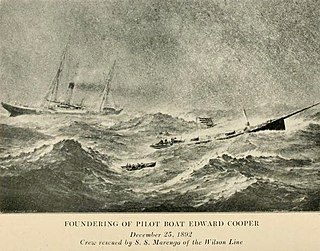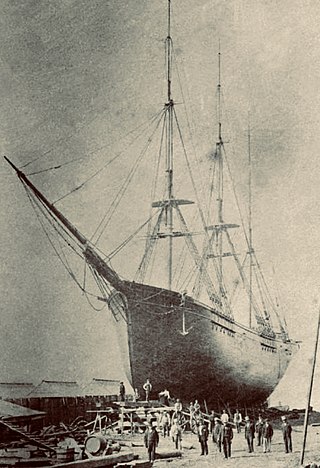
A pilot boat is a type of boat used to transport maritime pilots between land and the inbound or outbound ships that they are piloting. Pilot boats were once sailing boats that had to be fast because the first pilot to reach the incoming ship got the business. Today, pilot boats are scheduled by telephoning the ship agents/representatives prior to arrival.

Joseph Henderson was a 19th-century American harbor pilot who guided large vessels into and out of New York Harbor as a Sandy Hook pilot. During his long career his work included bringing the ship that carried the Statue of Liberty safely into port after its trip from Europe.
Isaac Webb, was a 19th-century shipbuilder, owner and founder of the Isaac Webb & Co. shipyard. He was one of the founders of shipbuilding in the United States.

C. & R. Poillon was a 19th-century shipyard company in Brooklyn, New York. The company employed over 300 workers, owned several shipyards, and launched 175 vessels. The company was one of the best known clipper ship firms and the last of the wooden hulled boat builders in New York.

The Columbia was a 19th-century pilot boat built C. & R. Poillon shipyard in 1879 for Sandy Hook and New York pilots that owned the Isaac Webb, which was lost off Quonochontaug Beach, Long Island in July 1879. She was run down by the Guion Line steamer SS Alaska in 1883. A second pilot-boat, also named Columbia, was built by Ambrose A. Martin at East Boston in 1894 that had a unique spoon bow and was extremely fast. She was thrown ashore in the great Portland Gale, and remained on the Sand Hills beach in Scituate, Massachusetts for over thirty years as a marine curiosity. The Louise No. 2 replaced the ill-fated Columbia.

The Moses H. Grinnell was a 19th-century pilot boat built in 1850 for the New York maritime pilots. She was designed by the yacht designer George Steers. The Grinnell was the first pilot boat to feature a fully developed concave clipper-bow, which was to become the New York schooner-rigged pilot boat's trade mark. This new design was the basis for the celebrated yacht America.

The Richard K. Fox, first named Lillie, was a 19th-century pilot boat built in 1876 for Boston Pilots. She was designed by model by Dennison J. Lawlor. She was one of the most graceful and attractive of the Boston pilot-boats and represented a trend toward deep-bodied boats. She was later sold to the New York pilots and renamed Richard K. Fox in honor of the famous sportsman and publisher of the Police Gazette. In the age of steam, she was sold in 1896 to the Marine Hospital Service.

The Washington was a 19th-century Sandy Hook pilot boat built in 1845 by C. & R. Poillon for New York Pilots. She was rebuilt several times, the last with the sail number "22" painted on her mainsail. In 1884, she was sunk by the German steamship Roma, and then replaced by a new Washington.

The Charles H. Marshall was a 19th-century Sandy Hook pilot boat built by Henry Steers in 1860 for a group of New York pilots. She was in the Great Blizzard of 1888, the same year the National Geographic came out with an article about the successful struggle made by the crew of the Marshall. The boat was named in honor of the American businessman Charles Henry Marshall. In the age of steam she was sold in 1896.

The Jacob Bell was a 19th century Sandy Hook pilot boat built by the shipbuilder Jacob Bell for a group of New York Pilots in 1840. She was named in honor of the shipbuilder Jacob Bell, who was a partner in the Brown & Bell firm. After fourteen years of service she went ashore in a gale off Sandy Hook in 1854.
The Ariel Patterson was a 19th century Sandy Hook pilot boat built in 1864 for a group of New York Pilots. She was built by the shipbuilder Ariel Patterson. After nineteen years of service, she was struck and sank off Sea Bright, New Jersey by the steamer Commonwealth in 1883. She was raised and purchased by the Coast Wreaking Company.

The Caprice was a 19th-century Sandy Hook pilot boat built in 1871 by Brown & Lovell in East Boston, Massachusetts for Peter McEnany and other New York pilots. In 1876, she was run down and sank, off Bay Ridge, Brooklyn, by the steamship New Orleans. She was raised and was one of the pilot boats that survived the Great Blizzard of 1888. The Caprice was last reported sailing off the coast of New York in 1891.

The Edward Cooper was a 19th-century Sandy Hook pilot boat, built in 1879 for New York Pilots at Greenpoint, Brooklyn. She was named in honor of the Mayor of New York City. The Edward Cooper helped transport New York City maritime pilots between inbound or outbound ships coming into the New York Harbor. She survived the Great Blizzard of 1888. In 1892, the Cooper sank in a snowstorm and was replaced by the Joseph Pulitzer in 1894.

Edward Francis Williams, was a 19th-century shipbuilder. He apprenticed under his father Jabez Williams. Edward F. Williams built his own shipyard, building clipper ships and eleven Sandy Hook pilot boats, some of the finest boats in the fleet. He was the first president of the Greenpoint Savings Bank. Williams died in New Providence, New Jersey, in 1902.
The Blossom was a 19th-century Sandy Hook pilot boat built for the New York pilots around 1837. She helped transport maritime pilots between inbound or outbound ships coming into the New York Harbor. In 1839, she came across the Slave ship La Amistad. In 1840, there were only eight New York pilot boats, the Blossom being No. 5. Pilot Thomas Freeborn of the Blossom boarded the packet ship John Minturn and tried to guide the ship in bad weather. He was one of thirty-eight passengers that died near the Jersey Shore in 1846.

The Coquette was a 19th-century yacht and pilot boat, built in 1845 by Louis Winde, at the Winde & Clinkard shipyard in Chelsea, Massachusetts for yachtsmen James A. Perkins. Her design was based on a model by shipbuilder Dennison J. Lawlor. The Coquette was a good example of an early American yacht with a clipper bow. As a yacht, she won the attention for outsailing the larger New York yacht Maria at the second New York Yacht Club regatta in 1846. Perkins sold the Coquette to the Boston Pilots' Association for pilot service in 1848. She continued as a pilot boat until 1867 when she was sold as a Blackbirder to be used on the African coast.
The E. K. Collins was a 19th-century Sandy Hook pilot boat built in the early 1840s. She was named for the American shipping magnate Edward Knight Collins. During a winter storm, the Collins ran ashore on the outer bar of Fire Island in 1856.

Thomas D. Harrison was a 19th-century New York pilot boat built for New Jersey pilots. She was launched from the Jacob S. Ellis & Son shipyard, at Tottenville, Staten Island in 1875. The Harrison went ashore in the Great Blizzard of 1888 with no lives lost. She continued as a pilot boat with Pilot Stephen Cooper in command. She was purchased in 1897 by Allerton D. Hitch and used for coastal trade in the Cape Verde islands off the west African coast.

Favorite or Favorita, was a 19th-century New York Sandy Hook pilot boat built in the early 1820s. She helped transport New York City maritime pilots between inbound or outbound ships coming into the New York Harbor. Favorite collided with a United States steamer and sank in 1865 near Barnegat Lighthouse.















